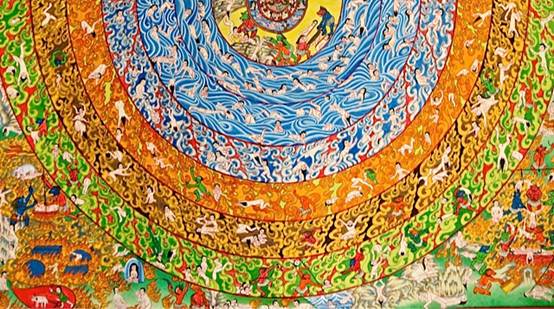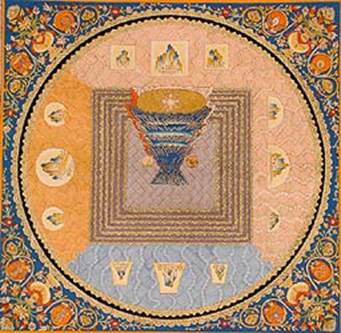
Colony Earth – Part XI: A School for Creator ‘gods’
What I have written here will not serve to move you towards Enlightenment. For
that you must dedicate time to your practice in whatever form you have chosen.
However it may motivate you, for understanding why we come here is surely a part
of our Liberation.
Reading further into the collection of Tibetan Buddhist scriptures on the Myriad
Worlds by Jamgon Kontrul (see below), we find descriptions of our universe that
correlate with similar passages in the Sanskrit Puranas. I am going to reflect
on both these viewpoints not only from the spiritual and metaphysical, but also
through the lens of ancient astronaut theory and the idea that colony Earth is
only one of many inhabited planets in this and 300+ billion or more galaxies.
I have taken the off-world position of reading the Tibetan and Sanskrit verses
through the eyes of an ancient astronaut, and interpret them through the filter
of the more current science and astrophysics. While simultaneously and
conversely, from my understanding of the cosmology and metaphysical wisdom found
in the ancient texts, I make a heartfelt effort to weave them into one. I stand
in both worlds.
In the Tibetan Buddhist view, our part of the universe is known as ‘Endurance’
because here all sentient beings endure emotions and sufferings. Here we learn
to patiently “endure hardship with exceptional courage and excel in bravery.”
Endurance is contained within one of the spaces of the twenty-five tiered
arrangement of world systems and is a third-order thousand worlds system. “This
third order thousand world-system of Endurance alone is encircled by buddha
realms equal in number to the particles of this thirteenth world system.”
The Land of Jambu is also the name given to our earth plane in the Tibetan
Buddhist system. We are told that we must not feel that our human life is
inferior to the others. “The Land of Jambu is a place for new evolutionary
actions.” This is the place where entities come to evolve; and the Tibetan texts
says that there are humans on “three other continents” [meaning other realms of
existence], but they “experience (only) the results of their past (actions),
they have no possibility of performing new evolutionary actions. Therefore these
places are inferior to Jambu.”

The Bhagavata Purana contains the Uddhava Gita, which is similar to the Bhavagad
Gita but is more explicit, more detailed and perhaps more accessible to some.
The Bhagavata Purana was composed much later, perhaps around 900 CE in the
Indian Middle Ages. In Chapter XI.10.21-26 we learn that the heavens are
temporal and still contain hierarchies. “Even great gods like Brahma do not
enjoy unmixed happiness, as they are aware of the tenure of their office. But
fools entertain futile egotism about it.”
Bhagavata Purana XI.10.21: “The heavenly happiness promised by the Vedas is also
vitiated with envy, jealousy, termination and decay, as in the case of pleasure
experienced on the earth.”
Those who have earned heavenly realms through ‘meritorious acts’ enjoy heavenly
pleasures like a god. “In a lustrous celestial car (provided with all luxuries)
earned by his meritorious acts, he, wearing a rich, attractive dress, sports
with the celestial damsels while being glorified by Gandharvas [celestial
musicians] in song.” So absorbed in
celestial pleasures, he is not aware of his impending fall. “But when the
balance of merits is exhausted, he is pushed down by Time and he falls
reluctantly.”
The beings dwelling in the higher heavenly worlds cannot evolve there. They go
to the specific world, a Loka, which they have earned by their merit and remain
there as long as that earned merit holds. At the end of their merit, they are
bumped back into Samsara, the endless wheel of birth and death. My understanding
is the ‘gods’ have no feelings, meaning they cannot feel our ordinary human love
or sadness as we mortals do. Without feeling, there can be no spiritual
progress, no evolution, and no experience of re-connecting. To show why our
realm is superior, the Tibetan Buddhist says, “Moreover, people [residing in the
earth plane] feel sad when hearing accounts of impermanence, etc., and so are
easily guided (onto the spiritual path).” The
text ‘Great Mindfulness Scripture’ says, “All four places of humans depend on
this one. …Here, there is the indestructible seat of enlightenment.”
This clearly makes the point that we come here to seek Enlightenment, to make
progress in this evolutionary school ‘Endurance’ and that humans living in other
realms, but which apparently do not have this “indestructible seat of
enlightenment” are somehow dependent on those of us who are here.

The Heaven of Clear Light
“The genesis of humans on this continent occurred when a god in (the heaven of)
Clear Light died and took miraculous birth here.” A similar idea is in the
pivotal moment in the Mahabharata when Indra invites the gods to take form on
earth with the other hosts of gods, who are able to assume any shape. Therefore
they all “take pleasure in descending to earth with varying portions of
themselves” to make the mission of the gods successful. The idea that the beings
dwelling in other realms or Lokas have the ability and choice to incarnate here
in human form is found in the Mahabharata, which often called the Fifth Veda.
The Tibetan text also says that the gods of the heaven of Clear Light followed
the first god, and one after another their numbers increased until there were
many. “All could travel through space,
had radiant bodies, and were sustained by the nourishment of meditative
concentration…” The understanding that we are nourished by meditation in the
first cycle of time is found in many of the Puranas. The Linga Purana [Chapter
39.7] says that meditation is the greatest activity during the first cycle of
time, the Satya or Krita Yuga,.
I will not labour to make exact connections between the Tibetan and the Indian
cosmologies. I am only showing ideas that I found close enough to be thought
provoking. I suggest that the Seers in Tibet and India had similar visions,
however it is possible that they did read each other’s written visions. As I
have stated previously, dates in India are an enigma.
The Sanskrit Puranas were written in the middle ages. All of them contain many
descriptions of the four cycles of time, and I have always found those in the
VAYU Purana most intriguing.
Chapter Eight: [At the end of the last Kalpa, after everything is burned by the
SAMVARTAKA fire]
23. Those who could not reach Tapa-Loka [the sphere-world of the seven Rishis],
had resorted to Janaloka [realm of the Siddhas, saints & pious men]. They began
to function as seeds for the future creation.
24. Abiding there, in the form of seeds for the subsequent creation, they on
being let loose (scattered) serve the purpose of progeny.
26. …As the mental sons of Brahma (the creator god), they work as accomplished
souls.
33. Whatever names and forms (these beings have) in the past Kalpa, they mostly
receive the same in the future Kalpas.
The verses go on to describe life in the first cycle of time, saying that
everything is created mentally, through contemplation in the mind. The people
“moved about wherever they pleased. They had acquired mental Siddhis.” 47.
48. In that Krita age [Satya Yuga], there was neither virtue nor evil. The human
beings were non-differentiated. They had equal longevity, happiness and beauty
(form).
49. In the beginning of the Kalpa, in the Krita age, neither virtue (Dharma) nor
evil (Adharma) existed. The people were born with their respective authority and
rights.
[So, there was no Bill of Rights necessary!]
51. Even when thousands of human being spread they had no obstruction, no clash,
no order.
55. Time was always pleasant when peoples’ desires were fulfilled. There were no
extremes in heat or cold. Whatever object they desired in their minds was
available everywhere and at all times.
According to this description in the Vayu Purana, there were no differences even
in the way humans looked. Actions were spontaneous and voluntary, without the
intercession of intellect [59]. There was no such thing as gain or loss, likes
or dislikes, friends or foes. We were devoid of desire, and thus did not want to
possess anything, nor did we favour one over another.
From this we may imagine our consciousness in the first cycle of time, before we
had lost our connection to the God-within. We may begin to feel an affinity, a
Remembrance of our real nature in the various teachings designed to help us
return to our original state of Being. Such resonant memories can serve to lead
us back Home — for the description
above sounds very much like the enlightened state of consciousness Krishna
recommends to Arjuna in the Bhagavad Gita, Chapter XII:
13: He who hates no being, friendly and compassionate; free from “mine” and free
from “I” – meaning free from attachment to possessions and egotism; indifferent
to pain and pleasure [sama-duhkha-sukhah], and patient.
14. Contented always, the yogi [united with the One], the self-controlled with
firm resolve; the mind [manas], the understanding and intelligence [buddhis] are
fixed on and devoted to [the Oneness].
15. He is indifferent, disinterested, pure, capable, and free from anxiety…
My intention in this series of articles on Colony Earth is to weave traditional
spiritual wisdom into and throughout cosmology, for in my view the two cannot be
separated. Our goal of Enlightenment and spiritual evolution may be perceived
within the revelations presented in an acceptance of the Myriad Worlds. Yes,
there are many other beings residing in a vast multiplicity, races, planets,
dimensions, advanced technology, and so on. This does not intrude on the fact
that our spiritual advancement and self-mastery is the sole purpose and reason
we come to this planet, our lovely small blue-green Earth.

Honey Cups
The Tibetan text says that after a time our ability to sustain ourselves on
meditation deteriorated and “a white earth nectar that tasted like honey
appeared.” The Vayu Purana [8.86-89] states, “…trees manifested… Invigorating
honey without bees, possessing sweet taste, scent and colour, exuded in them in
every leafcup. They maintained themselves with that honey… They were free from
ailments.”
“But as time elapsed, they [we] were overcome with greed… They forcibly took
possession of [the] trees and extracted from them the nectar and honey. …the
wish-yielding trees perished…along with the honey.”
The Tibetan version is only slightly different: “Eating copiously of this
[honey], they began to crave it. Consequently the nourishment of meditative
concentration and other qualities, including miraculous powers [Siddhis] and
even the nectar itself, disappeared.” In the Tibetan story another kind of food
is provided, a kind of creamy orange earth-food, but craving again causes the
loss of this and “the radiance of their bodies gradually deteriorated.”
Many researchers have suggested that extraterrestrials live in other dimensions,
and therefore have very different subtler and perhaps self-luminous bodies. My
understanding is that we did not have solid material bodies in the first cycle
of time, and that as time has continued to ‘cook’ our consciousness, the density
of our flesh and blood human bodies – as perceived by the five-senses - has
increased, perhaps gradually.
I believe in the first cycle of time the earth plane was self-luminous, meaning
lit from within and not from reflected light. The Tibetan text says, “due to the
force of collective evolutionary actions and the natural laws of existence, the
sun and moon began to illuminate the world.” I had never read this idea before,
but again I think of David Talbot’s radically different conception of our solar
system in his 1996 documentary 'Remembering the End of the World' that he bases
on ancient symbols in world mythology. Our ideas of the universe and physics are
rapidly changing. We didn’t even know our planet had a magnetic field until very
recently, and we also had no idea that the entire heliosphere was travelling
through space. Who gave us the technology to get beyond our solar system, far
out into space enough to learn these new and startling discoveries?
The inhabitants of the Myriad Worlds are what we call the extra-terrestrials, a
term that only means beyond earth. As the Tibetan texts have said, “These worlds
suffuse the ten directions; millions of worlds interpenetrate one another, and
each world contains billions of others. Billions more are contained within each
atom of each world.”
As the Tibetan translators have indicated, awareness of the sheer scope and
number of the Myriad Worlds is said to be suitable knowledge for those who have
reached a certain spiritual maturity, and who are ready for the higher
understanding of a vast system of cosmology.
“As a result, the mind breaks out of the cage of fixed concepts of definite
space and existence and enters the open space of myriad worlds without beginning
or end…”

It is my considered view that the Kali Yuga was brought on by a terrible war and
this war is the story depicted in the Sanskrit epic, The Mahabharata. The epic
poem may be actual history, but it is also as an archetypal war intended to
teach us as the author Krishna Dvaipayana Vyasa must have been an amazing
genius, a polymath, sage and Seer who had mastered all the Vedas and every
aspect of life.
I assert that during the battles radiation was released around the planet and
these invisible plumes of death greatly reduced human intelligence,
consciousness, and perception. We lost whatever Siddhic powers we still
possessed in the previous cycle of time, the Dvapara Yuga, and became trapped in
five-sense perception. After that we could no longer ‘see’ the Myriad Worlds.
The vast majority of us no longer had use of the ‘third eye’ that in the
previous cycles of time was normal.
In the Tibetan writings on the Myriad Worlds there is a section entitled, The
Origin of the Wheel-Monarchs. I understand that most translators of Sanskrit
will think of the word wheel as relating to time or to the chakras. However,
when I see the word chakra ‘wheel’ I think of flying ships, or as the Sanskrit
Vimana is most often translated into English – aerial ship.
The Tibetan texts says, “Wheel monarchs, who reign over the four continents
[inhabited by humans, one being our Jambu] (by virtue of their possession of) a
gold, silver copper or iron wheel, are said to appear in this world whenever the
lifespan rises above eighty thousand years.” In the Kali Yuga the lifespan is
usually no more than 100, therefore we understand that these wheel-monarchs only
‘appear’ in previous cycles of time, meaning to me that they are ‘seen’ and
interacted with in the cycles that precede this one.
The Tibetan text the Supreme Essence Commentary on Transcendent Wisdom in Eight
Thousand Lines, mentions a queen who is named ‘Born from a Mountain.’ In the
Sumerian Ninhursag means the 'Lady of the Sacred Mountain'. The Sanskrit word
for mountain is Parvati, Shiva’s consort. Parvati is known as the Daughter of
the Mountain, her father being Himanvan, lord of the mountains and the
personification of the Himalayas. Is this mountain a pyramid, or an orbiting
ship that has a pyramidal shape.

The idea of ‘wheels within wheels’ is found in speculative interest in space
ship technology. Remember the machine in the film ‘Contact’ that took Jodie
Foster into wormholes had wheels within wheels. The word ‘wheel’ appears very
often in the Rig Veda. The Sanskrit word is CHAKRA and has multiple meanings.
For example: The wheel (of a carriage, of the Sun’s chariot), [chariot often is
the English word used to translate aerial ship]; of Time; a discus or sharp
circular missile weapon; a potter’s wheel; an astronomical circle; a mystical
circle; a circular flight; a particular constellation in the form of a hexagram;
a form of military array – to give you a few, straight out of M. Monier-Williams
Sanskrit-English Dictionary. Chakra also refers to the seven wheels of energy in
the human body.
The Tibetan text the Great Mindfulness Scripture describes the ‘wheel’ thus:
“The precious wheel is made of gold, is five hundred leagues (in diameter) and
has one thousand spokes. Within a day it can travel one thousand leagues. By
power of the wheel, the king’s attendants, the elephant and so on, are able to
travel anywhere through space up to (the heaven of) the Thirty-three and can
hear what the king does not hear. The wheel eliminates rivals. It appeared from
space.”
Five hundred leagues is around 2000 miles. This precious golden wheel flies very
fast and can 'hear what the king does not' – meaning it has some kind of radar
detection or telecommunications system. If you were reading this Buddhist
scriptural text in the 8th century in Tibet perhaps your associations
would have been quite different than one reading it in 21st century
satellite connected to cyberspace.

The text mentions “the precious elephant” that “in a single day can circle the
Land of Jambu three times” and defeats the king’s adversaries. Perhaps the Pali
or Sanskrit word for 'elephant' once referred to a small but mighty and
unstoppable fighter airship. One other “precious” item described is a jewel that
has eight facets and equals the size of a man’s thigh. “It illuminates the night
up to a distance of one hundred leagues, and if the day is hot, it provides
cooling water of eight qualities. Within a radius of one hundred leagues, the
jewel eliminates all diseases and fulfils all wishes. It was presented by
Indra.” In the Sanskrit texts, Indra is said to be a station, not an individual
person. There have been many Indra’s in many Kalpas, and he is the titular head
king of the world of the gods.
Another insight from the Tibetan text is in the Features of Life section:
“Beings in lower (realms) do not see those in the higher.” Higher beings,
perhaps Bodhisattvas in Buddhist Thangka paintings are depicted as floating on
clouds while observing those less fortunate and unenlightened trapped in the
various rungs of delusion. They can see us, but we cannot see them – unless of
course by the intent of our spiritual practice or by birth, our ‘third eye’ is
developed and open to see.
As we evolve spiritually and are ready to embrace a larger Universe, we will
move out of the Kali Yuga, the Age of Confusion and Conflict. We have
voluntarily come here for a school of the cosmic kind that allows us to Veil the
God-within and experience limitation. Our true nature is that unlimited
ubiquitous Being pervading and permeating the entire universe — and this
pervading of the Oneness includes the Myriad Worlds, the “millions of worlds
interpenetrating one another” in a universe that we now know contains
300+billion galaxies.

The Treasury of Knowledge, Book One: Myriad Worlds, Jamgon Kongtrul Lodro Taye,
Kalu Rinpoche Translation Group; Snow Lion Publications, Ithaca NY, Boulder CO,
1995, 2003.
The LINGA PURANA, Part I, Translated by a Board of Svholars, Edited by Prof.
J.L. Shastri;
Motilal Banarsidass Publishers; Delhi, 1973, 1997.
The VAYU PURANA, Part I,
Translated & Annotated by Dr. G.V. Tagare;
Motilal Banarsidass Publishers; Delhi, 1987
The Bhagavadgita in the Mahabharata,
A Bilingual Edition,
Translated & Edited by J.A.B. van Buitenen;
The University of Chicago Press, 1981
The Bhagavad Gita,
Translated by Winthrop Sargeant;
State University of New York Press, 1994
The BHAGAVATA PURANA,
Translated and Annotated by Ganesh Vasudeo Tagare, M.A., PhD,
Part 5;
Motilal Banarsidass Publishers, 1976/1992; Delhi, India.
The Uddhava Gita, The Final Teaching of Krishna,
Translated by Swami Ambikananda Saraswati;
Ulysses Press, 2002

| Questions
or comments about articles on this site: Email V. Susan Ferguson: Click Here |
Copyright© V. Susan Ferguson All rights reserved. |
Technical questions or
comments about the site: Email the Webmaster: Click Here |